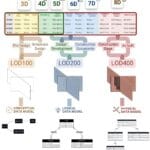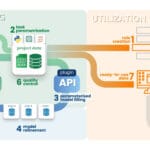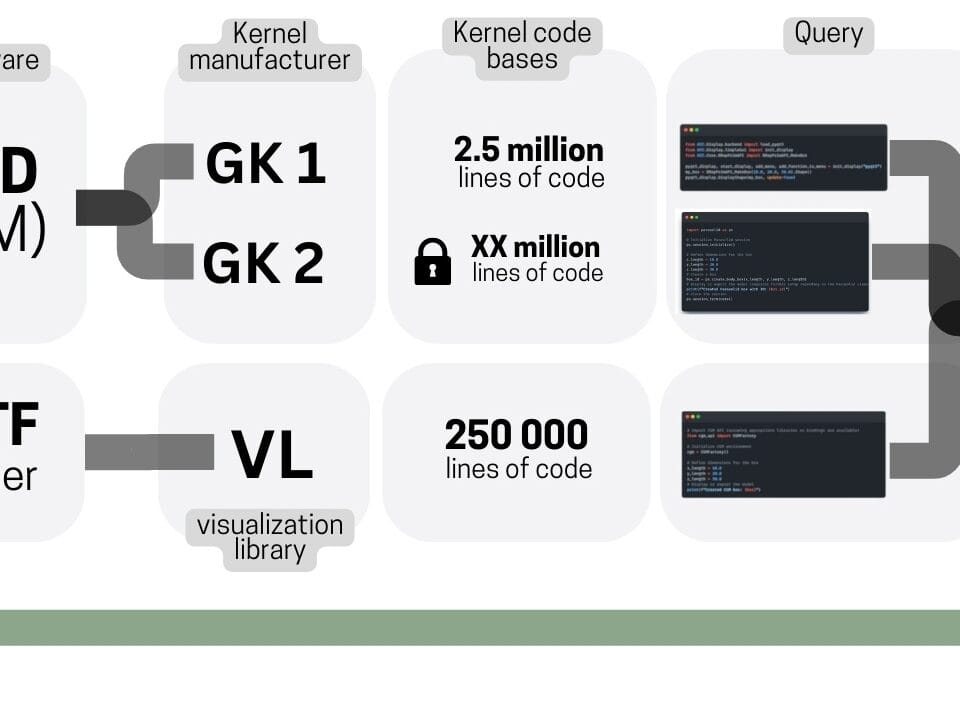Taking advantage of the lack of open access to CAD databases and limited competition in the data processing market, and using marketing campaigns related to the new acronym BIM, organizations involved in developing approaches to working with CAD data – have begun to create new standards and concepts that de jure should be aimed at improving data management practices.
While almost all initiatives directly or indirectly supported by CAD vendors and developers (BIM) have been aimed at optimizing workflows, they have resulted in a plethora of standards lobbied by various stakeholders, leading the construction industry to some ambiguity and confusion about data processes.
Let’s list some of the new data standards, in addition to LOD, LOI, LOA, LOG, that have emerged in recent years in the construction industry:
- BEP (BIM Execution Plan) – describes how to integrate and utilize CAD (BIM) in a project by defining data processing methods and processes.
- EIR document /AIA (Information Requirements of the client) – prepared by the client prior to the call for tender and contains the requirements for the contractor to prepare and provide information. It serves as the basis for the BEP in the respective project.
- AIM (Asset Information Model) is part of the BIM process. Once the project is delivered and completed, the data model is called the Asset Information Model or AIM. The purpose of AIM is to manage, maintain and operate the realized asset.
- IDS (Information Delivery Specification) – defines the requirements of and what data and in what format is required at different stages of a construction project.
- iLOD is the level of detail LOD, with which information is represented in the BIM -model. It defines how detailed and complete the information in the model is, from basic geometric representations to detailed specifications and data.
- eLOD – LOD level of detail of individual elements in a CAD model (BIM). It defines the degree of modeling of each element and associated information such as dimensions, materials, performance characteristics and other relevant attributes.
- APS (Platform Services) and other products from major CAD vendors (BIM) – describe the tools and infrastructure needed to create linked and open data models.
Although the declared purpose of implementing CAD (BIM) standards – such as LOD, LOI, LOA, LOG, BEP, EIR, AIA, AIM, IDS, iLOD, eLOD – is to improve the quality of data management and expand automation capabilities, in practice their use often leads to excessive complexity and fragmentation of processes. If we consider CAD (BIM) model as a kind of database, it becomes obvious that many of these standards duplicate long-established and effective approaches used in other industries when working with information systems. Instead of simplification and unification, such initiatives often create additional terminological burden and hinder the implementation of truly open and flexible solutions.
Notably, many of these new concepts are actually replacing the modeling and data validation processes that were discussed in detail in the first parts of the book and that have long been used in other sectors of the economy. In construction, however, the standardization process often moves in the opposite direction – new data description formats, new standards, and new concepts for data validation are created that do not always lead to real uniformity and practical applicability. As a result, instead of simplifying and automating processing, the industry faces additional levels of regulation and bureaucracy (Fig. 6.3-1), which is not always conducive to increased efficiency.
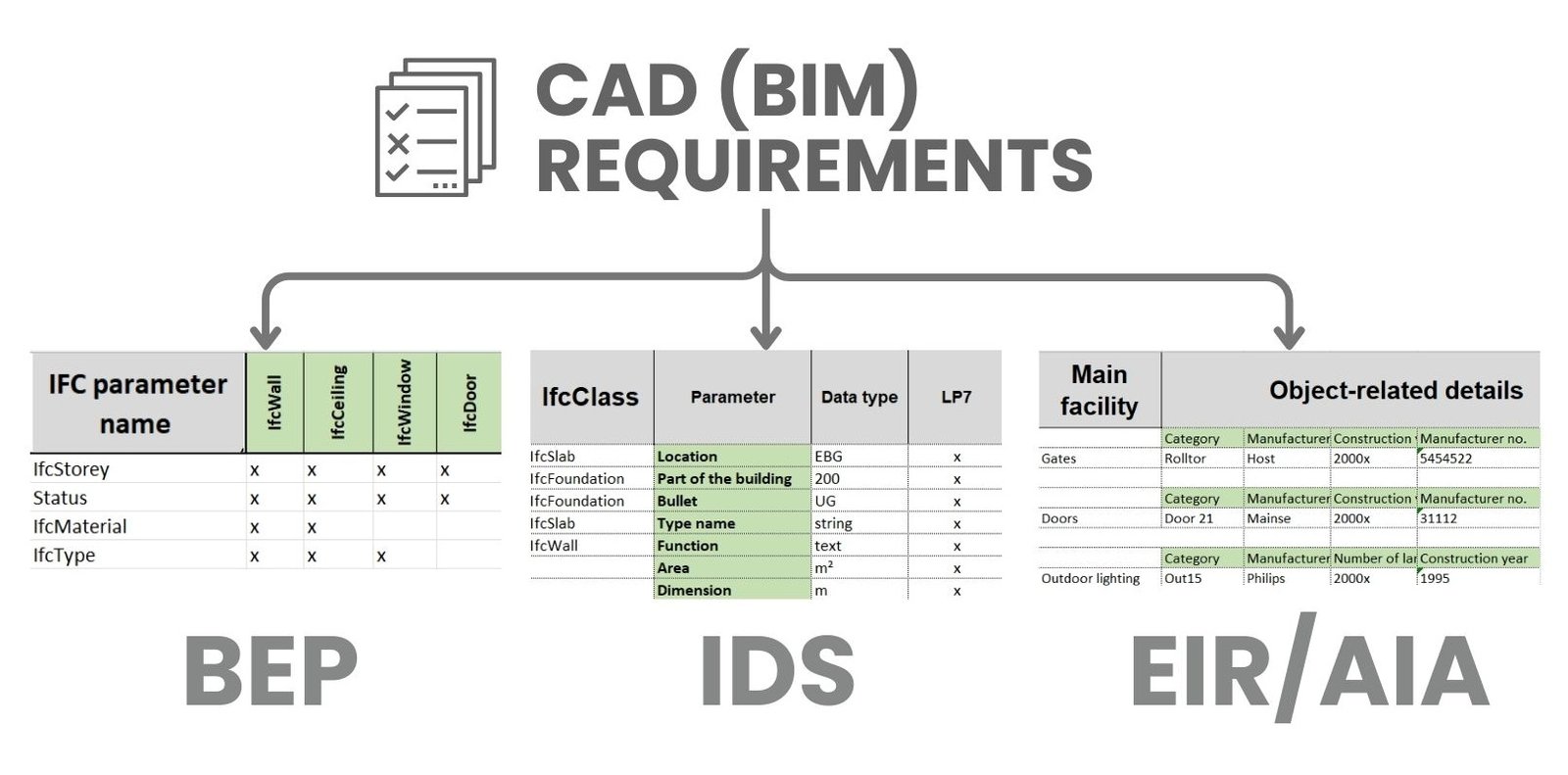
Instead of simplifying data processing, new concepts related to CAD (BIM) data more often generate additional complexities and disputes already at the stage of interpretation and basic definitions.
One of the latest examples of new concepts is the IDS format (introduced in 2020) which allows to describe the requirements for the attribute composition of an information model in the open BIM concept. IDS requirements describe information about attributes and their boundary values in the form of a structured table (Excel or MySQL), which is then translated into the markup of a semi-structured XML format, renamed from XML to the special abbreviation IDS.
Contrary to the view promoted by vendors and supported by BIM and open BIM, that data handling in construction is unique because of the use of specialized tools such as CAD and BIM, data formats and data management practices in this industry are not different from data handling formats and concepts in other industries
The number of requirements for CAD projects and formats (BIM) can be simplified by using a single requirements table with attribute-columns, detailed in the chapter “Translating Requirements into Structured Form”, without having to translate the originally structured requirements into non-table formats (IDS is initially described via a table).
The simplified approach (Fig. 6.3-2), which includes columns for entity identifiers, properties, and boundary values that were discussed in detail in previous chapters (Fig. 4.4-9, Fig. 4.4-16, Fig. 7.3-10), eliminates the need to convert requirements to IDS-XML format. This method provides a direct, less cumbersome, and more transparent mechanism for data quality control. It relies on widely used tools, from regular expressions (RegEx) to dataframes, Pandas, and standard ETL–Pipelines, just like those used by professionals in other sectors of the economy when working with data.
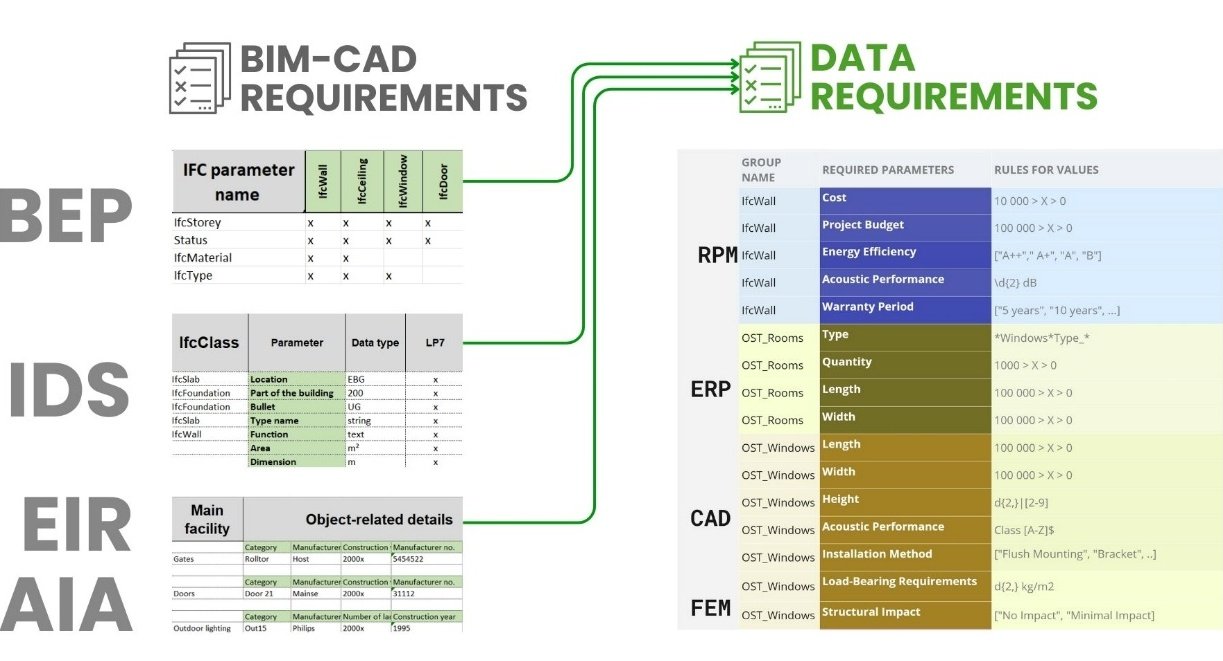
Over time in the construction industry, due to the closed nature of the data, more and more new approaches and techniques are emerging to control and manage this diverse data, even though the data in construction projects is essentially the same as in other fields. While other industries have successfully made do with standardized approaches to data processing, construction continues to develop new and unique data formats, requirements and validation concepts.
The methods and tools used to collect, prepare and analyze data in construction should not be fundamentally different from those used by specialists in other sectors of the economy.
The industry has developed a distinct terminological ecosystem that requires critical reflection and re-evaluation:
The STEP format is positioned under the new name IFC, supplemented by construction categorization, without taking into account the limitations of the STEP format itself.
The parametric format IFC is used in data communication processes despite the lack of a unified geometric core needed for visualization and computation.
Access to databases CAD -systems is promoted under the term “BIM “, with no discussion of the specifics of these databases and access to them.
Vendors promote interoperability through the IFC and USD formats, often without practicing them, using costly reverse engineering that they themselves have struggled with.
The terms LOD, LOI, LOA, LOG, BEP, EIR, AIA, AIM, IDS, iLOD, eLOD are used universally to describe the same entity parameters, without reference to modeling and verification tools long used in other industries.
The construction industry demonstrates that all of the above, although it sounds strange, is possible in the construction industry – especially if the main goal is to monetize each stage of data processing through the sale of specialized services and software. From a business point of view, there is nothing wrong with this. However, whether such acronyms and approaches related to CAD (BIM) really add value and simplify professional processes remains an open question.
In the construction industry, such a system works because the industry itself makes most of its speculative profits in these labyrinths of systems and acronyms. Companies interested in transparent processes and open data are rare. This complex situation will probably continue indefinitely – until customers, clients, investors, banks and private equity start demanding clearer and more informed approaches to information management.
The industry has accumulated an excessive number of acronyms, but they all describe the same processes and data requirements to varying degrees. Their real usefulness in simplifying workflows remains questionable.
While concepts and marketing acronyms come and go, the data requirements validation processes themselves will forever remain an integral part of business processes. Instead of creating more and more specialized formats and regulations, the construction industry should look to tools that have already proven effective in other areas such as finance, industry and IT.
The abundance of terms, acronyms and formats forms the illusion of deep elaboration of digital construction processes. However, marketing concepts and complex terminology often hide a simple but inconvenient truth: data remains hard to access, poorly documented and rigidly tied to specific software solutions.
To get out of this vicious circle of acronyms and formats for the sake of formats, it is necessary to look at CAD (BIM) systems not as magical information management tools, but as what they really are – specialized databases. And it is through this prism that one can understand where marketing ends and real work with information begins.

